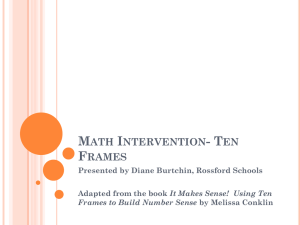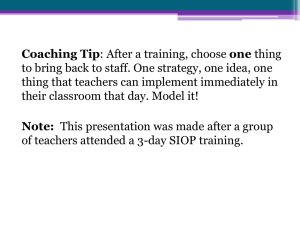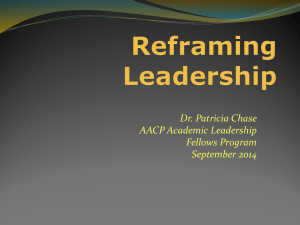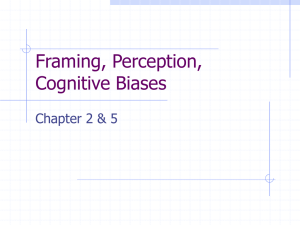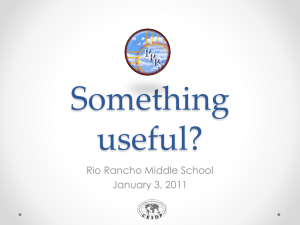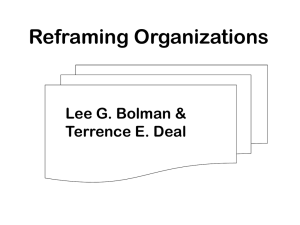Assessment
advertisement
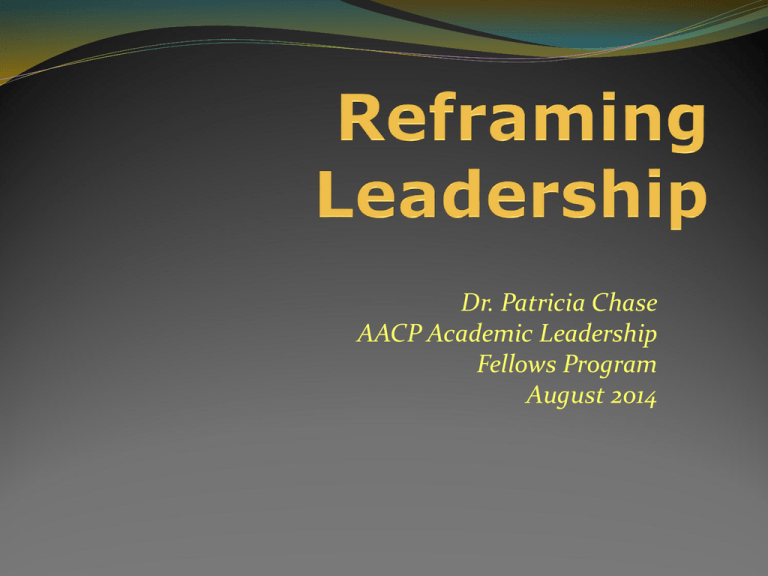
Dr. Patricia Chase AACP Academic Leadership Fellows Program August 2014 Our Leadership Studies this Week Talents Knowledge Skills But this session is focused exclusively on academic pharmacy – and you! Session Material Check •PowerPoint •Bibliography •Assessment instrument & scoring •List of symbolic frame ideas Comments from ALFP Fellows & Mentors “Now I know why a project failed that I thought I carefully designed. I didn’t design the project considering all four frames.” “I wish I knew this information 20 years ago!” “I took the tools home and immediately started seeing new things in my college.” “The frames help me solve problems in a new way. I’m much more effective.” “I used the four frames of leadership that I learned from the ALFP session.” (Karimi, R. – 2012 ALFP) We Are Not Trying to Make You Deans! We want you to enjoy the leadership role you have. We want you to be more effective in your current role by giving you tools to take back home. We want you to think about what comes next in your career. You are the future of the academy and it is important that we do succession planning. In the next 5 years there will be a tremendous number of positions open: Dean, Associate/Assistant Deans, and Department Chairs. Career opportunities will abound! My Leadership Journey Confessions of a leadership “junkie.” Dissertation: A Study of Academic Leadership (what it takes to become an excellent dean). The AACP New Deans Conference in 1994 changed my path – ALFP can be this for you. In my 14th year of being dean (both public and private) Dean’s Compass - many ALFP authors! Harvard Institute for Management and Leadership in Education (MLE) Like you, I’m a work in progress! The Concept of Frames Case study: Course in Ph.D. program. Assignment: To read the B&D book and apply the concepts to an organization. The course totally changed the way I look at an organization and make decisions. It began a 20+ year study of the concept of frames. Learned to use the frames to look at what is going on and then how to solve problems. Our Goals for Today To assess your preference for each of the frames. To describe the four frames that leaders can use to become more effective in solving organizational issues. To define the process of reframing and describe how it can be used to solve problems. To discuss how the four frames can be used to develop a stronger team. Private Goals: Our Journey To discuss leadership in a more personal context by sharing lessons we have learned on our personal leadership journeys. You’ll never see this in books! Please Note: Not all of the slides are in your handouts. This is intentional because some of this material reflects my personal journey. Our next session will allow your team facilitators to share their personal leadership stories - one of the best parts of the program! Our most important rule: What happens at Airlie stays at Airlie! Private Goals: Our Journey To have you begin considering the next steps on your leadership journey. Please use a page in your journal to write personal reflections about your leadership experiences. Remember: Some of the most important leadership lessons you will learn during “bad” times or from poor leaders. “They will make you better or bitter.” There are no right or wrong answers! Be honest, don’t try to second guess the survey. Please take ten minutes to complete it the 32 items. To score the assessment, put the numbers in the appropriate spaces on the scoring sheet. Add the numbers and put the total in the box. We will discuss your results in a few minutes. The Concept of Frames Lee Bolman and Terry Deal wrote the book: Modern Approaches to Understanding and Managing Organizations in 1984. Seven years later it was released as Reframing Organizations: Artistry, Choice and Leadership. The 4th edition was released in 2008. Frames are views (lenses) of an organization that provide a context for much of the existing theory and research on organizations. The Four Frames •The Structural Frame – Factories/Machines •The Human Resource Frame - Families •The Political Frame – Jungles •The Symbolic Frame – Temples/Theaters Organizations have all four frames! If you don’t recognize this, you may be unaware of the forces that prevent you from solving problems. Frames …“are both windows on the world and lenses that bring the world into focus.” …“filter out some things while allowing others to pass through easily.” …“help to order experiences and decide what action to take.” Bolman and Deal 2003 By the end of this session you will not only know your preference for each frame, but you will also apply these lenses to solve common problems that face faculty leaders every day. The Harvard Program Institute for Management and Leadership in Education (MLE). Two week intensive program. Lee Bolman facilitated four days to using the frames to solve problems in higher education. Bolman used a two step process – frame analysis/problem resolution. Assessing Your Survey Structural Human Resource Political Symbolic Are you equally strong in all four frames? Is there one that is move dominant? My Report Card - 1993 Frame Structural Human Resource Political Symbolic Grade + + - Advantages of Frames Similar to the StrengthsFinder - when you know your “frame” strengths you can work to enhance your understanding of your dominant frame(s). You can develop your understanding and abilities in the other frames. The frames can be learned. Knowledge of frames can keep you out of trouble. Reframing is a critical skill and it can also be learned. What is reframing? Reframing The ability to examine the same situation from multiple vantage points to develop a holistic picture. Given a problem, you should use each of the lenses to see it more clearly. Effective leaders change lenses when things don't make sense or aren’t working. Reframing offers the promise of powerful new options to solve problems. The ability to reframe experience enriches and broadens a leader’s repertoire. Bolman and Deal 2003 Reframing “If all you have is a hammer, everything looks like a nail.” Format for discussion of Frames For each frame: Definition of leadership styles that are prominent Example of how the frame applies to higher education Advantages of the frame Potential problems in the frame Personal reflections Sharing reflections – personal and group The Structural Frame Emphasizes goals, rules, formal relationships and the rational side of an organization. The Structural Frame A structural leader clarifies goals, attends to the relationship between structure and environment and develops a structure that is clear to everyone. A structural leader focuses on tasks, facts and logic rather than personality and emotions. A structural leader defines roles and responsibilities; clarifies organizational goals. You must have structure, otherwise organizations misdirect energy and resources! Structural Frame Leader Authoritarian, analyst, architect, military model, bureaucrats. Frequently believes that organizations require tight control. However, it doesn’t have to be. In specialized areas where you have higher levels of expertise and performance (professions) a less complex structure works. Here, the structural approach should be broad and more subtle. The Structural Frame in Education Change strategy: Analyze, design, implement. Organizations operating in rapidly changing turbulent times need more complex, yet flexible structures. Leaders must understand the complexity of the organization and create the right structure. Important elements of the structural frame include: Policies and procedures; organizational chart; departmental structures; job descriptions; accreditation and assessment, and strategic plans/goals. Structural Frame Problems Balance between architect and tyrant. Too rigid structure; ignores everything that falls outside the rational jurisdiction of structures (P&P). Red tape, mindless memos and micromanagers. Cold, heartless; neglect other variables that are critical to organization’s effectiveness. Organizational problems originate from inappropriate structures and can be resolved by simple reorganization. The terrible secretary! Personal Reflections When you are new to an organization, look at the structural problems first. These problems can get you into trouble! Focus on data, logic, plans, policies. Listen for at least the first 6 months. Try not to change anything. Assess your current structure:. Do you have structural problems – e.g. accreditation, bylaws, policies and procedures, strategic plan, an efficient organizational structure? 3 Tips: •Don’t compare your new organization’s structure to an old one. •Be careful that your organization doesn’t becomes too “comfortable.” •Bring in consultants “prn.” Personal Reflections Please put one personal reflection on the structural frame in your journal. Do you know someone who is a very structural person? Personal Reflections Please share a personal reflection with the group The Human Resource Frame Emphasizes needs, attitudes, skills and the human side of an organization. The Human Resource Frame Human resource leaders believe that people are the heart of any organization. When people feel the organization is responsive to their needs and supportive of their goals, you can count on their commitment and loyalty. Human resource leaders believe there is a synergistic relationship between organizations and people. The fit between the organization and the people must be good. If it is, both benefit, if not, one or both will suffer. A HR Frame Leader Believes organizations exist to identify and meet human needs. Taps into people’s talents and strengths; is totally committed to developing his/her people. Works to get, and keep the best people. Recognizes strengths in his/her people; builds excellent teams. Holds a personal belief in the quality of his/her employees. Allows people to do important work and make mistakes (occasionally). Please read MacGregor! Is a servant, catalyst, caregiver, mentor, educator. Knows that change comes from building relationships, listening, empowering. The Human Resource Frame in Education Recruiting – get the right people on the bus in the right seats. Dealing with difficult issues – get the wrong people off the bus.(Check out Jim Collins Good to Great in the Social Sectors – discusses higher education). Retaining excellent faculty. Designing faculty development programs. With the shortage of faculty, number of new schools, and mobility of junior faculty the HR frame is critical! Human Resource Frame Problems Balance: Catalyst or wimp? Romanticized view of human nature in which everyone always hungers for growth and collaboration; is too optimistic. Wishy-washy leadership: Good guys make bum bosses! Spends too much time on the trouble makers; forgets to reward the good people. Blinded by people; fails to be fair; plays favorites. Personal Reflections Personal Reflections Make the tough decisions; always try for a win/win in personnel decisions. Hire people who are not completely qualified. Focus on communications, teamwork. Skinner: “Take no leftovers.” Make it “good to be good.” “Unless the job means more than the pay, it will never pay enough!” Personal Reflections on the HR Frame My Thank You Tree – Servant Leadership Personal Reflections Personal Reflections Please put one personal reflection on the HR Frame in your Journal Personal Reflections Please share a personal reflection with the group The Middle Management Trap Structural and human resource approaches may help you build a successful career in middle management. You will not rise to top leadership positions if you cannot reframe in more than these two. Warriors and Wizards Bolman and Deal wrote The Wizard and the Warrior: Leading with Passion and Power. Managers typically rely on two frames (structural and human resource) when they need four! Political and symbolic frames are required to make sense of the chaos that exists in organizations today. These are the two frames that leaders are usually the weakest. This book focuses on developing leaders as Warriors – to learn to command power, and as Wizards – to learn the mastery of symbols. Warriors and Wizards Warriors: this role mobilizes strengths, demonstrates courage and willingness to fight as long and hard as needed to win the battle/fulfill their mission. Wizards: this role brings imagination, creativity, meaning and magic to the organization. So let’s find out how to become Warriors: And Wizards: In Pharmacy Education The Political Frame Emphasizes power, conflict, and coalitions among those who have vested interest to protect and advance an organization in a context of scarce resources. Political Frame Leader A political frame leader is an advocate, negotiator, warrior. A political frame leader recognizes political realities and knows how to deal with them. Inside and outside any organization there are always a variety of interest groups and coalitions, each with its own agenda. There are never enough resources. A political frame leader recognizes his/her major constituencies and develops ties to them. A political frame leader knows that power and conflict are central features of organizational life; accepts the fact that leadership requires managing conflict as productively as possible. The Political Frame Leader Key skills: Agenda setting Mapping the political terrain Networking and forming coalitions Bargaining and negotiating to reach compromise Managing resources effectively Understanding the many sources of power Assessing risks and opportunities Change comes from putting all these skills into play: developing networks, building allies (even with people you don’t like), bargaining, jockeying for power and negotiating solutions. The Political Frame in Education Higher education environment: chronic scarcity, diversity and conflict. Resources are especially scarce in universities – but politics are not! Leaders need to build a base of support. Leaders need to be political and spend time building networks to key decision makers. It takes time and patience to do this. May be hard for new leaders to learn! Political Frame Problems Balance: Advocate or hustler? Unethical politicians: amoral, scheming and unconcerned. Spend more time advancing one’s career. Enticed by the perks of leadership positions. Too diffuse; work doesn’t get done. People are rewarded for political games; this creates unhealthy competition, and reinforces conflict and mistrust. Personal Reflections Personal Reflections Integrity is #1 – in all actions! Every organization has politics – get over it - you must learn to play the game. Map your political terrain. Know who has the power. Build access to key decision makers. Learn to negotiate to win/win. Seek first to understand!! Meet with people you don’t know, but who have power. Listen to them and learn. Presence is critical and part of the game. If you are not at the table; you lose. Become bilingual. EI issues – social skills/even golf! Personal Reflections Boxing gloves are required occasionally! Pick your battles carefully Personal Reflections The story of Gordan Gee and the kitchen table! Build your network! Personal Reflections Please put one personal reflection on the Political Frame in your journal. Do you like politics? Personal Reflections Please share a personal reflection with the group The Symbolic Frame Explores how organizations create meaning and belief through symbols-including myths, rituals, and ceremonies. The Symbolic Frame A symbolic leader knows what is most importanabout any event is not what happened, but what it means to people. A symbolic leader uses dramatic, visible symbols. They create a cultural tapestry of rituals, ceremonies, and stories to help people find meaning, purpose, and passion. A symbolic leader believes that the most important part of a leader’s job is to inspire. Give people something that they can believe in – a vision! People become excited and committed to an organization that is special. A symbolic leader knows in the face of uncertainty and ambiguity people create symbols to resolve confusion, increase predictability and anchor hope. A Symbolic Frame Leader Is charismatic. Is a prophet or poet. Articulates a vision that differentiates the organization’s unique capabilities and mission. Creates slogans, tells stories, gives awards, appears where she/he is least expected; MBWA - manages by walking around/riding lawnmowers! Tells stories, creates drama. Is sensitive to an organization’s history and culture. Is visible and energetic. Is passionate about making his/her organization the best. Has faith in the future. Symbolic Frame in Education Education is tremendously symbolic – think of the ceremonies, academic regalia, special events, tributes, etc. This is not understood or recognized in many colleges. This failure contributes to many problems. Walking into a school you can easily diagnose a symbolic frame deficit no The symbolic frame is especially important in times of rapid change – you can use it to change the culture of an organization – given time. This is a critical skill for all leaders. The Symbolic Frame Problems Balance: Prophet or zealot? Symbols only work when they are attuned to people and place. Meaningless symbols antagonize and empty symbolic events backfire. A good example is the meaningless words in a vision statement that no one owns. Faced with uncertainty and ambiguity, people create symbols to resolve confusion, increase predictability and provide direction – this may be good or bad! Personal Reflections on the Symbolic Frame Personal Reflections on the Symbolic Frame Rod M’s Story: “Where is the most important place for me to be right now?” OR Personal Reflections on the Symbolic Frame You are the cheerleader; there are a lot of anthropologists in higher education Symbolic Frame at Work Symbolic Frame at Work Personal Reflections on the Symbolic Frame Events/metaphors/symbols are important Look at constituent groups: Students: White Coat Ceremony, Hooding Ceremony, Dinners with the Dean, Nickel for a Name. Faculty/staff: Crock pot, Throw Down, Decorating Days, CQI. Alumni: reunions, tailgates, etc. Please refer to your handout and help me get to 200! Personal Reflections Please put one personal reflection on the Symbolic Frame in your journal Personal Reflections on the Symbolic Frame Please share a personal reflection with the group Discussion Questions Is there a frame that you don’t understand, don’t like? Is there a frame you would like to explore in greater detail? How many frames do you use? How many frames should you use? Research by Bensimmon: In a study of 32 university presidents: 1 frame 13 2 frames 11 3 frames 7 4 frames 1 Bolman and Deal: Modern organizations are so complex they cannot be understood from a single-frame perspective. Leaders who use only one or two frames may be extremely vulnerable to changes in climate or competition. Four Frame Leaders Work to understand the situation by looking at it from the perspective of all four frames – this involves a combination of analysis, intuition and artistry. They take the most appropriate action(s) to resolve the situation. Developing a Team You don’t have to be good in all four frames. You can build a team using the concepts and recruit people with strength(s) in the frame(s) where you are weak. Think of the incredible organization you can have if you have team strength in all four frames. Assignment: In the space on your assessment instrument place the names of your team members and their scores in the boxes. Case Study Question…. You are the new dean/assistant or associate dean/department chair in a school/college of pharmacy. As you build your team, are there any frames you could not delegate to someone else? If there are any, why? Structural? Human Resource? Political? Symbolic? Now let’s think about your school/college…. If you had to rate your college/school would you say it is primarily structural, human resource, political or symbolic? Is your supervisor (department chair/dean) more developed in one of the frames? Does he/she operate in more than one frame? If your supervisor (department chair/dean) uses only one frame, how will you “manage him/her?” Reframing Reframing is the ability to view the same thing from more than one perspective. One of the most important parts of the concept. When you use frames as lenses that bring your world into focus, you can use the frames to help you see what needs to be done to solve problems. Each frame/perspective has a unique, comparative advantage. Each is likely to be more salient and illuminating in some circumstances than in others. Exercise: Reframing Reframe each situation to determine what is going on by looking at the problem through each of the four frames, or lenses. What frames are the most important? What do the frames show you? What steps should you take to solve the problem? Case #1 Your state’s financial resources are extremely poor; your faculty has not had a raise for two years. You don’t want to lose talented faculty. Case #2 You just received a call that one of your brightest P4 pharmacy students has died secondary to a drug overdose. Case #3 You are the new department chair in a college with very low faculty morale. Faculty members hide in their offices, backstab each other, and have developed “alliances.” When You Go Home Look/observe/listen. Make a list of the people in your organization. Understand what frame(s) they use. Are there any frames that are overly dominant in your college/school? Are there any that are missing? If so, how can you correct the problem? Always ask yourself: “Where is the best place for you to be?” When You Go Home Reflect on your progress in becoming a leader and list the areas you want to develop. Write your observations in a leadership journal. Read B&D: The Wizard and the Warrior: Leading with Passion and Power. Read MacGregor and the Monkey. Send ideas to get to 200 Symbolic tips. Leadership Wise leaders understand their own strengths, work to expand them, and build teams that can provide leadership in all four frames-structural, political, human resource and symbolic. Leadership Lessons Leadership is a wonderful, lifelong journey. References – Please see Bib Special Thanks Lee Bolman Brad, Emily, Ruth and…. Special Thanks to You!


